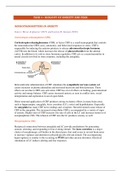TASK 4 – BIOLOGY OF ANXIETY AND FEAR
NEUROTRANSMITTERS IN ANXIETY
Source: Meyer & Quenzer (2013) and Lecture B. Janssen (2018)
Corticotropin-releasingfactor (CRH)
Corticotropin-releasinghormone (CRH, or factor CRF) is a small neuropeptide that controls
the neuroendocrine (HPA axis), autonomic, and behavioral responses to stress. CRF is
responsible for inducing the anterior pituitary to release adrenocorticotropic hormone
(ACTH) into the blood, which increases the release of glucocorticoids from the adrenal
cortex. In addition to its role in stress hormone regulation, CRF acts as a neurotransmitter in
neural circuits involved in stress response, including the amygdala.
Intraventricular administration of CRF stimulates the sympathetic nervous system and
causes increases in plasma adrenaline and increased heart rate and blood pressure. These
effects are not due to HPA axis activation. CRF has a lot of effects on feeding, gastrointestinal
activity and energy balance. CRF causes increased anxiety as seen in conflict tests, social
interpretation and exploration in novel open fields.
Direct neuronal application of CRF produces strong excitatory effects in many brain areas,
such as hippocampus, amygdala, locus coeruleus (LC), cortex and hypothalamus. Especially
the amygdala has many CRF nerve endings and -receptors. Stressful stimuli cause release of
CRF in the amygdala. The increased extracellular CRF is accompanied by a variety of signs
of anxiety. Higher rates of CRF increases fire rate of cells in the LC and increases turnover of
norepinephrine (NE). The infusion of CRF into the LC produces anxiety as well.
Norepinephrine (NE)
Reciprocal connections between amygdala and LC provide mechanisms for generating
arousal, orienting, and responding to fear-evoking stimuli. The locus coeruleus is a major
cluster of noradrenergic cell bodies in the dorsal pons, that send axons to several brain areas
to increase vigilance and attention to physiologically relevant stimuli. The accompanying
hypervigilance is similar to the occurring in PTSD and other anxiety disorders. Electrical
stimulation of LC induces alerting and fear responses.
, Second, NE is the neurotransmitter released at the target
visceral organs, including the heart, during sympathetic
activation. Additionally, the catecholamine adrenaline
(epinephrine) produces widespread effects that prepare the
individual to respond to danger. Individuals with panic
disorder and PTSD have more dramatic body responses to
anxiety-provoking stimuli, and war veterans with PTSD
have higher circulating NE.
Third, both NE and epinephrine have a significant role in the formation of emotional
memories that may contribute to anxiety disorders in which memories can influence behavior
(agoraphobia, panic, PTSD). The normal enhancement of memory by catecholamines may
help us remember what is emotionally significant; in the case of PTSD, those memories
become intrusive and are re-experienced over and over.
▪ Modifying NE function with drugs may represent a useful treatment for
PTSD. It may be possible to interfere with formation of traumatic memories by
blocking beta-adrenergic receptors right after a severe trauma.
▪ It may also be possible to modify existing traumatic memories because beta-
adrenergic agonists may have a role in reconsolidation processes. It is
believed that recalling or retrieving a memory makes it temporarily unstable
and susceptible to interference that would prevent reconsolidation.
Therefore, it was suggested that the use of beta-adrenergic antagonists (for
example, propranolol) may disrupt the already consolidated traumatic
memories and associated physiological responses of those suffering PTSD.
Propranolol treatment also was effective in disrupting emotional memories that
have been consolidated and retrieved in response to a learned fear cue or
personalized trauma scripts. The beta-blocker given before retrieval of
emotional memory does seem to significantly diminish the emotional effects.
Fourth, some of the therapeutic effects of
anxiolytics can be explained by modulation
of LR firing. Noradrenergic cells in the LC
are excited by CRF synaptic input and are
inhibited by y-aminobutyric acid (GABA)
and serotonin (5-HT), as well as by
stimulation of alfa2-adrenergic
somatodendritic autoreceptors. Since
benzodiazepines enhance the inhibitory
function of GABA, reduced LC firing may be
responsible for at least some of the anxiolytic
effects. 5HT-reuptake blockade by SSRIs
would likewise reduce LC firing.
Figure; different emotional responses
, The figure shows some of the anxiolytic
effects of the benzodiazepines (BDZs),
tricyclic antidepressants (TCAs),
monoamine oxidase inhibitors (MAOIs)
and selective serotonine reuptake
inhibitors (SSRIs) may be explained by
their inhibitory effect on locus coeruleus
neurons.
On the other hand, corticotropin-releasing
factor (CRF) increases anxiety and has
excitatory effects on the LC. CRF
antagonists may be effective in reducing
anxiety.
Y-aminobutyric acid (GABA)
The inhibitory amino-neurotransmitter GABA has a major role in moderation of anxiety. The
GABAA-receptor complex comprises a chloride channel than when opened following GABA
allows Cl- to enter the cell, causing hyperpolarization. Several sedative-hypnotics enhance
the function of GABA, causing sedation, reduced anxiety and anticonvulsant effects.
Benzodiazepines and barbiturates produce these effects by binding to distinct modulatory
sites different from the GABA binding site on the receptor complex.
GABA binds to a site near the junction
of alpha and beta subunits on GABAA.
This causes conformational changes
that open chloride ion channel.
Because more negatively charged
chloride ions diffuse to intracellular
space, the neuronal membrane is
hyperpolarized. Benzodiazepines bind
to another site, which facilitates GABA
binding and increase the frequency of
chloride channel opening. Without
GABA, benzodiazepines are inactive.
Barbiturates bind and increase the duration of chloride channel
opening, both in the presence and in absence of GABA; thus, GABA is
not needed, and therefore these agents are more toxic than
benzodiazepines. Ethanol binds to a distinct site on the ionophore and
enhances chloride influx. BDZ binding sites are highly distributed in
the brain (PET scan on the left)




